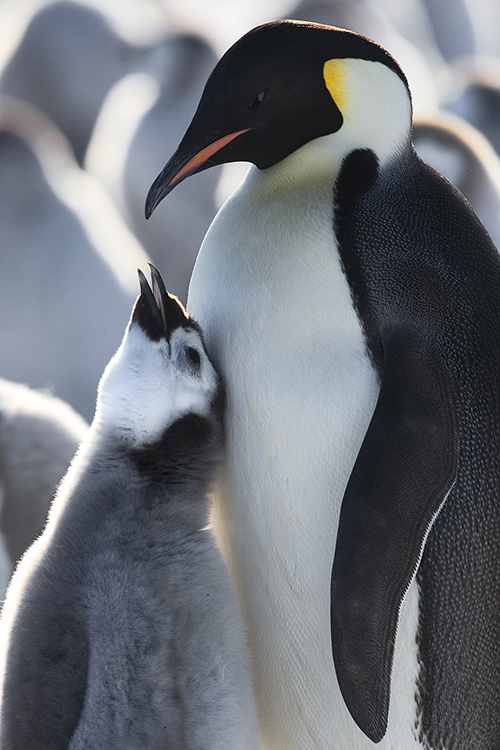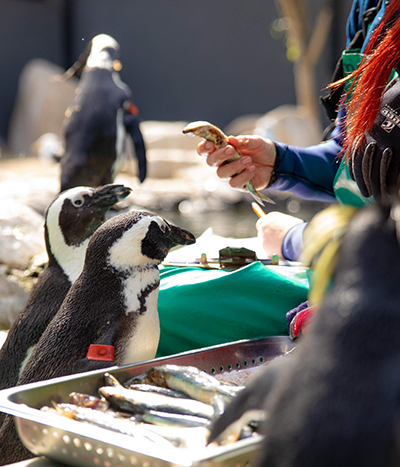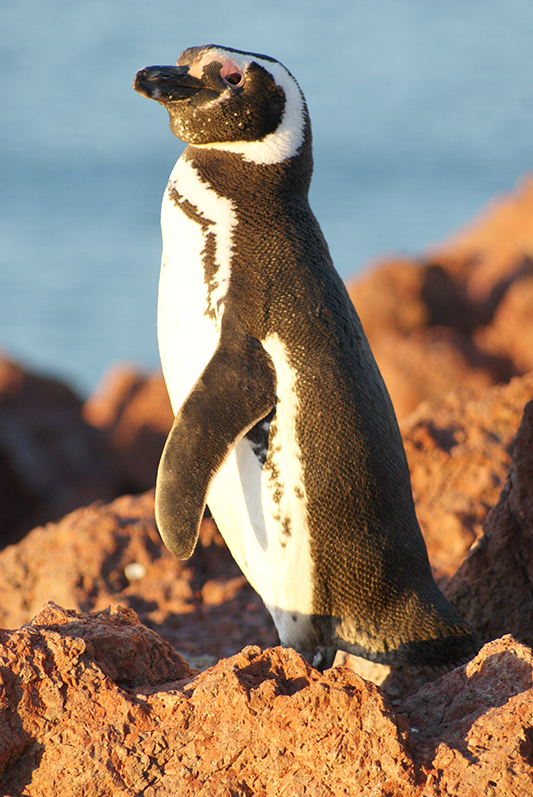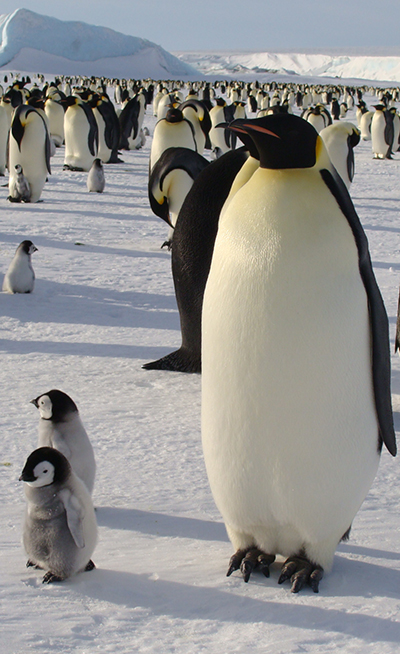Penguins In Peril
By Michael LaChance
They’re sports mascots and cartoon characters, holiday decorations, and stuffed toys. No doubt about it, the power of this black-and-white creature rules. Penguins are a hit with their quirky charm. But it’s going to take more than a pop-culture obsession for these sleek, entertaining, and endearing birds to survive.
Penguins are flightless birds that breed in colonies, have Happy Feet, and are sometimes called Chilly Willy—there’s also no denying that they’re extremely cute (and well-dressed: hello tuxedo coats!) creatures. These Southern Hemisphere birds live and breed in colonies, and like most wildlife, need our help. Luckily, many organizations are working to fight climate change, disturbance to habitat, and other things that put these picture-perfect birds at risk. We spoke to leaders in this avian rescue community to see what’s affecting penguins and how we can help.
CLIMATE CHANGE IMPACT
It’s no longer possible to ignore the effects of climate change. As Pablo Garcia Borboroglu from the Global Penguin Society explains, “The earth’s current climate change is no longer a prediction. It is unequivocal and when combined with other threats, there’s a direct impact on the iconic penguin species. Some Antarctic regions are warming much faster than the average rate of the earth’s overall warming. Alterations in the patterns of ice formation and melting, together with increasing rain and snow precipitations, have changed breeding and feeding habitat quality and availability.”
It’s no longer possible to ignore the effects of climate change. As Pablo Garcia Borboroglu from the Global Penguin Society explains, “The earth’s current climate change is no longer a prediction. It is unequivocal and when combined with other threats, there’s a direct impact on the iconic penguin species. Some Antarctic regions are warming much faster than the average rate of the earth’s overall warming. Alterations in the patterns of ice formation and melting, together with increasing rain and snow precipitations, have changed breeding and feeding habitat quality and availability.”
Pablo tells us temperate species (outside Antarctic regions) are also altered by climate variation. And, since they don’t fly and travel for food, climate change can hinder their survival.

Dr. Katta Ludynia from Southern African Foundation For The Conservation Of Coastal Birds (SANCCOB) tells us about the shifts in fish distribution and changes in African penguins’ most important prey: sardine and anchovy. “The lack of fish has dramatic effects on many of South Africa’s seabirds, especially the African penguin. Climate change also negatively affects their breeding as extreme weather events (heat waves, cold spells and storms) lead to nest abandonment,” she says.
This affects the Little Penguin species too. Roland Pick from the Penguin Foundation says, “they feed on pilchards, anchovies, squid and sea jellies from the ocean’s pelagic layer.” In ideal circumstances, this remains at a fairly constant temperature.” However, he says, “as ocean’s temperatures rise, the penguins preferred food source may move deeper into the ocean to avoid increasing water temperatures, into areas deeper than penguins can dive.”
HUMAN INTERFERENCE
For penguin colonies, human activities pose some of the most damaging threats. There are fisheries, fishing nets that entangle penguins, oil spills, and pollution. And don’t forget about plastic! As Pablo says, “Oil spills killed thousands of penguins in four continents, and now plastic pollution is also affecting them—we found penguins entangled, with plastic bottles around their necks or plastic bags strangling them. Penguins also eat small pieces of plastic that harm—and can kill—them too.”
Dr. Ludynia tells us about habitat destruction among African penguin colonies, saying, “St Croix Island, the world’s largest African penguin colony, is located close to the Port of Ngqura, the deep-water port on the east coast of South Africa. Population numbers have declined since port expansion, and activities like ship-to-ship bunkering and increased shipping traffic have begun to eradicate the South African penguins.”
Roland says that an imbalance of the ocean’s biodiversity and food web can result from overfishing. “Marine debris is also a risk, and sometimes it’s the little things we do or change, that make a difference. One of the prime offenders is helium balloons. Eventually, they come back down and deflate in the ocean. A deflated balloon can look like a sea jelly, which is part of the penguins’ diet,” he explains.

In New Zealand, the extinction of yellow-eyed penguins (which Rosalie Goldsworthy tells us is predicted to happen within 10 years on Mainland NZ) is caused by anthropomorphic effects. “Between our desire to get into their spaces, our pets, and our commercial greed, we are destroying an iconic species that has survived for 60 million years,” she says.
“We need to be mindful of disposing rubbish (especially plastic) appropriately. It ends up in our waterways, which drain into our oceans, so the onus is on us to do the right thing,” Roland adds.
SAVE THE PENGUINS
Rosalie Goldsworthy believes the first step, especially in NZ, is to advocate for dogs to be on leads or muzzled at the beach. As she explains, “When a penguin is struggling, it will come ashore to rest and recover. If a dog gets it at this point, it will die. If you come across a penguin on the beach, in the daytime, something is wrong. Call authorities.
She reminds us, “Saving penguins is skilled work, but we can’t do it if we don’t find them. New Zealand wildlife is adapted for aerial predators who will freeze when disturbed. This does not mean that they like you; it means they are terrified. Let’s co-exist with our iconic species by giving them the space they need to live.”
Pablo tells us, “Because of cultural evolutions, the way we live has moved us away from nature. We ignore how much we need the environment to keep us mentally and physically healthy. This is unsustainable. We need to increase awareness and educate communities about sustainability.” Even though climate change may be difficult to grasp for some people, small changes like avoiding single-use plastics at home can help.
Education is also important—organizations like the Global Penguin Society give out educational material (check out the books, Sea Messengers, and Penguins: Natural History and Conservation) to create awareness.
Volunteering can also help foundations like this continue their work. SANCCOB explains that as non-profits, they rely on donations. “Veterinary care, medication, rehabilitation, and fish for feeding are all covered by fundraising,” they explain.
PREDATOR PREDICAMENTS
Even without human interference, penguins can face issues in the wild. Rosalie tells us that her organization works primarily for yellow-eyed penguins “through optimizing habitat, maximizing survival and breeding, minimizing disturbance, enhancing management through science, advocating for penguin conservation, and managing the risk of disease.” She also says the loss of habitat occurs “as more coastal areas are given over to farming, predation, disease, human disturbance, and starvation. The mainland predator is dogs.”
Even without human interference, penguins can face issues in the wild. Rosalie tells us that her organization works primarily for yellow-eyed penguins “through optimizing habitat, maximizing survival and breeding, minimizing disturbance, enhancing management through science, advocating for penguin conservation, and managing the risk of disease.” She also says the loss of habitat occurs “as more coastal areas are given over to farming, predation, disease, human disturbance, and starvation. The mainland predator is dogs.”
Even without human interference, penguins can face issues in the wild. Rosalie tells us that her organization works primarily for yellow-eyed penguins “through optimizing habitat, maximizing survival and breeding, minimizing disturbance, enhancing management through science, advocating for penguin conservation, and managing the risk of disease.” She also says the loss of habitat occurs “as more coastal areas are given over to farming, predation, disease, human disturbance, and starvation. The mainland predator is dogs.”
In New Zealand, the extinction of yellow-eyed penguins (which Rosalie Goldsworthy tells us is predicted to happen within 10 years on Mainland NZ) is caused by anthropomorphic effects. “Between our desire to get into their spaces, our pets, and our commercial greed, we are destroying an iconic species that has survived for 60 million years,” she says.
“We need to be mindful of disposing rubbish (especially plastic) appropriately. It ends up in our waterways, which drain into our oceans, so the onus is on us to do the right thing,” Roland adds.
SUCCESS STORIES
Looking for some success stories to brighten your day? Remember, research and rescue have already done a world of good. The Global Penguin Society combines scientific problem identification with approaching governments to establish protected areas and helping to put it all in place. However, as Pablo says, “Often in the countries in which we operate, Governments are unstable, and Administrations change all the time so, by involving communities we have higher stability and continuity.” They’ve helped protect 32 million acres of habitat for penguins, benefiting 2.4 million penguins worldwide.
And then there’s Australia’s Penguin Foundation’s Summerland Peninsula story from 1985. With research as the cornerstone of the Phillip Island Nature Parks operations, it’s no surprise that this helped save the day here. After a scientific staff paper predicted that the world’s most famous colony of Little Penguins at the Penguin Parade could be extinct here by 2000, something had to be done. Roland explains, “This was the last of the original 10 penguin colonies on Phillip Island before European settlement, and the findings set off alarm bells across the community and Government.”
Luckily, with the help of a paper that included measures to protect the Little Penguins and their habitat, a new program helped the colony rebuild from just 12,000 to 30,000 breeding birds.

Seeing that this is possible, all we need to do is spend more time, energy, and resources protecting precious wildlife like the penguins. As Rosalie so aptly puts it, “Adults share their time and resources with others. We need to share the planet too!”

You can learn more about the organizations we’ve mentioned. Remember, following foundations on social media, donating, and volunteering is a great way to spread awareness. Here’s a jumping-off point:
Penguin Rescue
Sign up to help the penguins at Penguin Rescue NZ. For an associate membership fee, you get a calendar and weekly penguin updates by email. Info: penguins.org.nz.
The Global Penguin Society
This international organization that fosters the conservation of penguin species and their associated ecosystems are engaged in much research. Help support their research or volunteer your time. They also have education programs. Info: globalpenguinsociety.org.
Southern African Foundation For The Conservation Of Coastal Birds
SANCCOB is internationally recognized, helps with the response, rehabilitation, chick-rearing, and contributes to research and training programs. It has an Adoption Program where you can adopt an egg or an African penguin to contribute to the incubation, hand-rearing, and rehabilitation. You can donate online as well. Info: sanccob.co.za.
The Penguin Foundation
From performing penguin rescues during oil spills to training people, they focus on rescue and rehab and are always looking for donations. They also have a volunteer program that always needs people willing to help. Info: penguinfoundation.org.au.





